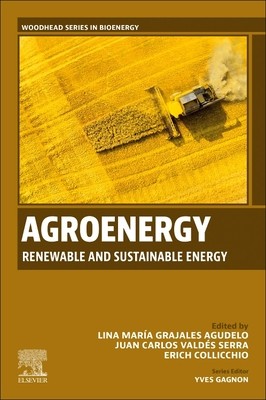
- We will send in 10–14 business days.
- Publisher: Woodhead Publishing
- ISBN-10: 0443214301
- ISBN-13: 9780443214301
- Format: 15.2 x 22.9 x 2.1 cm, softcover
- Language: English
- SAVE -10% with code: EXTRA
Agroenergy (e-book) (used book) | bookbook.eu
Reviews
Description
Agroenergy: Renewable and Sustainable Energy presents recent innovations and research developments in agroenergy. With a particular focus on sustainability, each section of the book - crop productivity, biofuel production based on feedstock generation, and bioenergy production technologies - addresses a different aspects of the agroenergetic production chain, identifying strategies for enhanced yields and reduced risk that can be applied to future research and current operations.
In Part I, on crop productivity, the book explains the theoretical and economic aspects related to crop productivity, along with issues related to circular economy, life cycle assessments, and the impact of future climate scenarios. Part II, biofuel production based on feedstock generation, describes the valorization of biomass residues, notably empty fruit bunches from the oil palm sector, sugar cane crop residues, dairy industry, cooking oil, cassava, wastewater, cattle manure, and microalgae. Finally, Part III, on bioenergy production technologies, addresses pretreatment issues, the importance of microorganisms, the coupling of biodegradable polymers and the ethanol and biodiesel industry, solid-state fermentations, and bioreactor design.
Agroenergy: Renewable and Sustainable Energy will be of interest to scientists, researchers, engineers, and industrial practitioners, along with graduate and postgraduate students working on any aspect of the agroenergy sector.
EXTRA 10 % discount with code: EXTRA
The promotion ends in 20d.18:49:51
The discount code is valid when purchasing from 10 €. Discounts do not stack.
- Publisher: Woodhead Publishing
- ISBN-10: 0443214301
- ISBN-13: 9780443214301
- Format: 15.2 x 22.9 x 2.1 cm, softcover
- Language: English English
Agroenergy: Renewable and Sustainable Energy presents recent innovations and research developments in agroenergy. With a particular focus on sustainability, each section of the book - crop productivity, biofuel production based on feedstock generation, and bioenergy production technologies - addresses a different aspects of the agroenergetic production chain, identifying strategies for enhanced yields and reduced risk that can be applied to future research and current operations.
In Part I, on crop productivity, the book explains the theoretical and economic aspects related to crop productivity, along with issues related to circular economy, life cycle assessments, and the impact of future climate scenarios. Part II, biofuel production based on feedstock generation, describes the valorization of biomass residues, notably empty fruit bunches from the oil palm sector, sugar cane crop residues, dairy industry, cooking oil, cassava, wastewater, cattle manure, and microalgae. Finally, Part III, on bioenergy production technologies, addresses pretreatment issues, the importance of microorganisms, the coupling of biodegradable polymers and the ethanol and biodiesel industry, solid-state fermentations, and bioreactor design.
Agroenergy: Renewable and Sustainable Energy will be of interest to scientists, researchers, engineers, and industrial practitioners, along with graduate and postgraduate students working on any aspect of the agroenergy sector.


Reviews